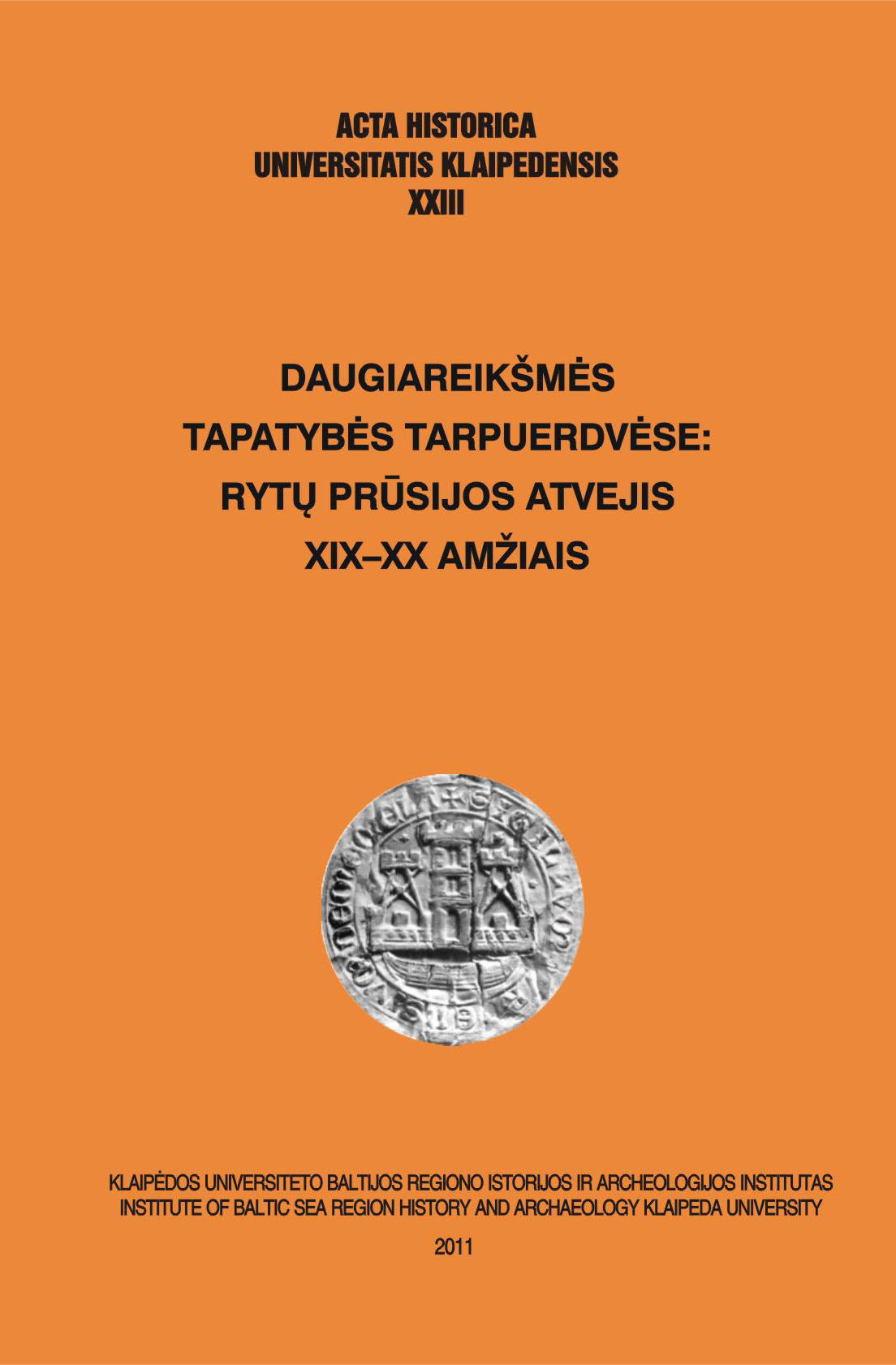Volume 23 (2011): Daugiareikšmės tapatybės tarpuerdvėse: Rytų Prūsijos atvejis XIX–XX amžiais = Ambiguous Identities in the Interspaces: The Case of East Prussia in the 19th and 20th Centuries = Die vieldeutigen Identitäten in den Zwischenräumen: Der Fall Ostpreußen…, November 2011

Order by:
Pub. online: 28 Nov 2011
Type: Introduction
 Open Access
Open Access
Journal:
Acta Historica Universitatis Klaipedensis
Volume 23 (2011): Daugiareikšmės tapatybės tarpuerdvėse: Rytų Prūsijos atvejis XIX–XX amžiais = Ambiguous Identities in the Interspaces: The Case of East Prussia in the 19th and 20th Centuries = Die vieldeutigen Identitäten in den Zwischenräumen: Der Fall Ostpreußen…, pp. 5–7
Pub. online: 28 Nov 2011
Type: Introduction
 Open Access
Open Access
Journal:
Acta Historica Universitatis Klaipedensis
Volume 23 (2011): Daugiareikšmės tapatybės tarpuerdvėse: Rytų Prūsijos atvejis XIX–XX amžiais = Ambiguous Identities in the Interspaces: The Case of East Prussia in the 19th and 20th Centuries = Die vieldeutigen Identitäten in den Zwischenräumen: Der Fall Ostpreußen…, pp. 8–11
Pub. online: 28 Nov 2011
Type: Introduction
 Open Access
Open Access
Journal:
Acta Historica Universitatis Klaipedensis
Volume 23 (2011): Daugiareikšmės tapatybės tarpuerdvėse: Rytų Prūsijos atvejis XIX–XX amžiais = Ambiguous Identities in the Interspaces: The Case of East Prussia in the 19th and 20th Centuries = Die vieldeutigen Identitäten in den Zwischenräumen: Der Fall Ostpreußen…, pp. 12–15
Pub. online: 28 Nov 2011
Type: Article
 Open Access
Open Access
Journal:
Acta Historica Universitatis Klaipedensis
Volume 23 (2011): Daugiareikšmės tapatybės tarpuerdvėse: Rytų Prūsijos atvejis XIX–XX amžiais = Ambiguous Identities in the Interspaces: The Case of East Prussia in the 19th and 20th Centuries = Die vieldeutigen Identitäten in den Zwischenräumen: Der Fall Ostpreußen…, pp. 16–30
Abstract
Pub. online: 28 Nov 2011
Type: Article
 Open Access
Open Access
Journal:
Acta Historica Universitatis Klaipedensis
Volume 23 (2011): Daugiareikšmės tapatybės tarpuerdvėse: Rytų Prūsijos atvejis XIX–XX amžiais = Ambiguous Identities in the Interspaces: The Case of East Prussia in the 19th and 20th Centuries = Die vieldeutigen Identitäten in den Zwischenräumen: Der Fall Ostpreußen…, pp. 31–68
Abstract
Pub. online: 28 Nov 2011
Type: Article
 Open Access
Open Access
Journal:
Acta Historica Universitatis Klaipedensis
Volume 23 (2011): Daugiareikšmės tapatybės tarpuerdvėse: Rytų Prūsijos atvejis XIX–XX amžiais = Ambiguous Identities in the Interspaces: The Case of East Prussia in the 19th and 20th Centuries = Die vieldeutigen Identitäten in den Zwischenräumen: Der Fall Ostpreußen…, pp. 69–103
Abstract
Pub. online: 28 Nov 2011
Type: Article
 Open Access
Open Access
Journal:
Acta Historica Universitatis Klaipedensis
Volume 23 (2011): Daugiareikšmės tapatybės tarpuerdvėse: Rytų Prūsijos atvejis XIX–XX amžiais = Ambiguous Identities in the Interspaces: The Case of East Prussia in the 19th and 20th Centuries = Die vieldeutigen Identitäten in den Zwischenräumen: Der Fall Ostpreußen…, pp. 104–127
Abstract
Pub. online: 28 Nov 2011
Type: Article
 Open Access
Open Access
Journal:
Acta Historica Universitatis Klaipedensis
Volume 23 (2011): Daugiareikšmės tapatybės tarpuerdvėse: Rytų Prūsijos atvejis XIX–XX amžiais = Ambiguous Identities in the Interspaces: The Case of East Prussia in the 19th and 20th Centuries = Die vieldeutigen Identitäten in den Zwischenräumen: Der Fall Ostpreußen…, pp. 128–135
Abstract
Pub. online: 28 Nov 2011
Type: Article
 Open Access
Open Access
Journal:
Acta Historica Universitatis Klaipedensis
Volume 23 (2011): Daugiareikšmės tapatybės tarpuerdvėse: Rytų Prūsijos atvejis XIX–XX amžiais = Ambiguous Identities in the Interspaces: The Case of East Prussia in the 19th and 20th Centuries = Die vieldeutigen Identitäten in den Zwischenräumen: Der Fall Ostpreußen…, pp. 136–144
Abstract
Pub. online: 28 Nov 2011
Type: Article
 Open Access
Open Access
Journal:
Acta Historica Universitatis Klaipedensis
Volume 23 (2011): Daugiareikšmės tapatybės tarpuerdvėse: Rytų Prūsijos atvejis XIX–XX amžiais = Ambiguous Identities in the Interspaces: The Case of East Prussia in the 19th and 20th Centuries = Die vieldeutigen Identitäten in den Zwischenräumen: Der Fall Ostpreußen…, pp. 145–157
Abstract